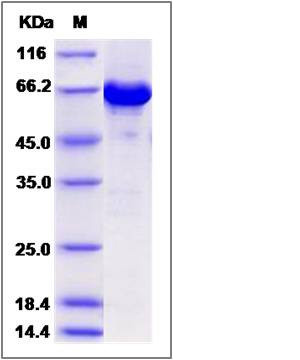Mouse AKT3 Protein (aa 106-479, His & GST Tag)
AI851531,D930002M15Rik,Nmf350
- 100ug (NPP3174) Please inquiry
| Catalog Number | P51027-M20B |
|---|---|
| Organism Species | Mouse |
| Host | Baculovirus-Insect Cells |
| Synonyms | AI851531,D930002M15Rik,Nmf350 |
| Molecular Weight | The recombinant mouse AKT3/GST chimera consists of 611 amino acids and has a calculated molecular mass of 71 kDa. The recombinant protein migrates as an approximately 65 kDa band in SDS-PAGE under reducing conditions. |
| predicted N | Met |
| SDS-PAGE |  |
| Purity | > 90 % as determined by SDS-PAGE |
| Protein Construction | A DNA sequence encoding the mouse AKT3 (Q9WUA6-1) (Ala106-Glu479) was expressed with the N-terminal polyhistidine-tagged GST tag at the N-terminus. |
| Bio-activity | No Kinase Activity |
| Research Area | Cancer |Signal transduction |Other Related Intracellular Topics |Apoptosis Intracellular Kinases |
| Formulation | Lyophilized from sterile 20mM Tris, 500mM Nacl, pH 7.4, 10% glycerol 1. Normally 5 % - 8 % trehalose and mannitol are added as protectants before lyophilization. Specific concentrations are included in the hardcopy of COA. |
| Background | v-akt murine thymoma viral oncogene homolog 3 (AKT3), also known as PKB-GAMMA, with AKT1/PKBalpha, AKT2/PKBbeta, are the memerbers of Akt kinase family, share extensive structural similarity and perform common as well as unique functions within cells. The Akt signaling cascade initiates at the cell surface when growth factors or other extracellular stimuli activate phosphoinositide 3-kinase (PI3K). AKT3 was discovered to be the predominant isoform activated in sporadic melanomas. Levels of activity increased during melanoma progression with metastatic melanomas having the highest activity. Although mechanisms of AKT3 activation remain to be fully characterized, overexpression of AKT3 and decreased PTEN activity play important roles in this process. Targeted reduction of AKT3 activity decreased survival of melanoma tumor cells leading to inhibition of tumor development, which may be therapeutically effective for shrinking tumors in melanoma patients. AKT2 and AKT3 play an important role in the viability of human malignant glioma cells. Targeting AKT2 and AKT3 may hold promise for the treatment of patients with gliomas. |
| Reference |
